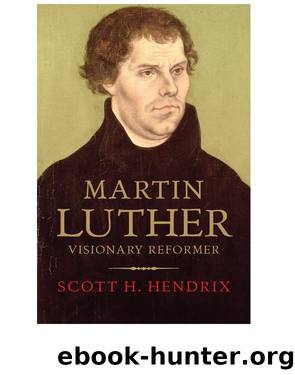Martin Luther by Scott H. Hendrix

Author:Scott H. Hendrix
Language: eng
Format: epub
ISBN: 9780300166699
Publisher: Yale University Press
CHAPTER TWELVE
A COARSE AND UNRULY PEOPLE 1526â1527
WittenbergâTorgau
âWe Germans are a wild, coarse, and unruly people. It is hard to start anything new with them unless dire circumstances force them to it.â1
In 1525 the profile of the German Reformation began to change. According to historians, before 1525 momentum for the reform movement came from the bottom up, that is, from the laity and clergy who read the compelling pamphlets written by Luther and many others. After 1525 the momentum came from the top down as reforms were established by princes and magistrates in the territories and towns they governed. The early evangelical movement was a populist endeavor, a wildfire that no one controlled, but beginning in 1526 the civil authorities brought the conflagration under control. The support of civil authority was necessary for the evangelical movement to survive the attacks of its enemies: the Catholic emperor and princes in Germany and the Catholic cantons in Switzerland. Moreover, there was no separation of church and government in pre-reformation Europe, no tradition of legitimate free churches. Despite the tension between secular rulers and Roman bishops, parishes and monasteries were subject to one or both of these overlords. However, once princes and town councils were convinced by the evangelical message, they disregarded the bishops, challenged the emperor, and decided by themselves to approve or reject changes in religious policies proposed by the Protestant reformers.
As a rule, historians have lamented the shift from populist movement to government-authorized reforms, but for the most part Luther did not. Elector John was a stronger supporter of the reformation than his deceased brother, the former Elector Frederick, ever was. Frederick had grudgingly allowed a few reforms but Elector John threw his full weight behind the proposals submitted by Luther and his colleagues. By 1526 the religious profile of Wittenberg was undergoing conspicuous alterations. No monks were left at the Franciscan cloister and the Augustinian house was now occupied by Martin, Katharina, and their housekeeper. The All Saintsâ Chapter was on its last legs. Few, if any, former priests and friars were seen on the streets. German was used in worship at the Town Church near the square. Latin was still used for the Sunday mass in the Castle Church, but when it was time for the sacrament, German words of institution replaced the Latin prayer of consecration and both bread and wine were offered to communicants. Elector John attended worship in the Castle Church when he was in town. It remained the university chapel and continued to be used for academic celebrations, disputations, and funerals. Both Luther and Melanchthon would later rest there.
The German order of service that became standard for Sunday worship at the Town Church was adopted soon after Christmas of 1525. Long promised and finally completed by Luther, the German Mass reached a wide audience, not only because Luther wrote in German but also because he insisted that it was adaptable: âDo not make it a rigid law to bind or entangle anyoneâs conscience, but use it in Christian liberty as long, when, where, and how you find it to be practical and useful.
Download
This site does not store any files on its server. We only index and link to content provided by other sites. Please contact the content providers to delete copyright contents if any and email us, we'll remove relevant links or contents immediately.
| Anglican | Baptist |
| Book of Common Prayer | Calvinist |
| Episcopalian | Inspirational |
| Lutheran | Methodist |
| Pentecostal & Charismatic | Presbyterian |
| Quaker | Seventh-Day Adventist |
| Shaker | Theology |
Angels by Billy Graham(1888)
How To Be Born Again by Billy Graham(1731)
Peace with God by Billy Graham(1643)
Unbroken Curses by Rebecca Brown & Daniel Yoder(1519)
God's Prophetic Symbolism in Everyday Life by Adam Thompson & Adrian Beale(1447)
The School of Biblical Evangelism by Ray Comfort(1392)
Call by Rick Joyner(1366)
Martin Luther: The Man Who Rediscovered God and Changed the World by Eric Metaxas(1354)
Power over the Enemy by John Osteen & Joel Osteen(1316)
Jonathan Edwards: A Life by Marsden George M(1195)
Fresh Wind, Fresh Fire by Jim Cymbala(1191)
Prayers That Bring Healing and Activate Blessings: Experience the Protection, Power, and Favor of God by John Eckhardt(1188)
Liturgy of the Ordinary by Tish Harrison Warren(1182)
The Supernatural Power of a Transformed Mind Expanded Edition: Access to a Life of Miracles by Bill Johnson(1173)
Unmasking the Devil: Strategies to Defeat Eternity's Greatest Enemy by John Ramirez(1162)
An Altar in the World by Barbara Brown Taylor(1154)
Reformation Theology by Littlejohn Bradford(1146)
Seeing the Voice of God: What God Is Telling You through Dreams and Visions by Smith Laura Harris(1104)
Martin Luther by Mansch Larry D.; Peters Curtis H.;(1103)
